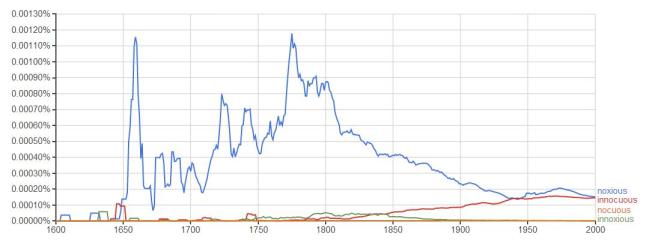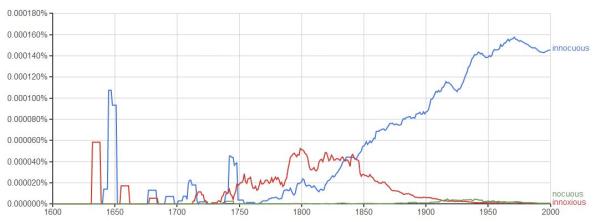This is why I keep a blog:
Me: “Mum, the OED’s word of the day is fascinating, it’s-”
Mum: “-Mhm, that’s nice.”
Apparently although I’m in my twenties I haven’t grown out of the 10-year-old me’s need to share ‘facts’ that other people don’t find remotely interesting. This blog is really in existence because I need somewhere to ramble about things I find cool.
The word of the day today is nocuous, adj: ‘Noxious, hurtful; venomous, poisonous’. (1627)
Nocuous comes from classical Latin nocuus (harmful) plus -ous suffix. Nocuus came from nocēre (to hurt, injure) + uus suffix. Innocuous developed later however I had only heard of innocuous, not nocuous.
Noxious stems from classical Latin noxius (harmful, injurious, guilty), from noxa (harm, injury).
Nocuous and noxious have similar meanings. The only difference I can see is noxious can also mean a guilty or irritating person. (Interestingly, its antonym, innoxious, no longer means someone who’s innocent). The earliest recorded use of nocuous is 1627, while noxious is over 100 years earlier. I’m guessing our favouring of one over the other is because they have such similar uses in common English so there was no need for such close synonyms in the language? However, it doesn’t explain why their antonyms don’t follow the same pattern: innocuous is more common than innoxious.
I used Google Ngram Viewer to have a look how often the words and their antonyms appeared in google books.

We can see that noxious is used far more often than the other three words, but it drops in usage until the 1930s when it starts slowly appearing again. Innocuous slowly increases in usage until it’s now used as often as noxious. Innoxious and nocuous are used a lot less often and so don’t show up well on the graph.
I took off noxious so the pattern of the others is clearer.

It looks like nocuous was never particularly commonly used in writing. While innoxious was more commonly used than innocuous at one point it drops steadily in the 1840s when innocuous gains usage.
The trends are similar when we look at just their uses in fiction, suggesting that a scientific use isn’t skewing the results. I wish I knew why we use noxious and innocuous, but not their opposites innoxious and nocuous. From the second graph we can see that noxious and innoxious were originally the preferred terms, as I’d expect, but that this changes in the 1800s.
I really love the inconsistency of language.


